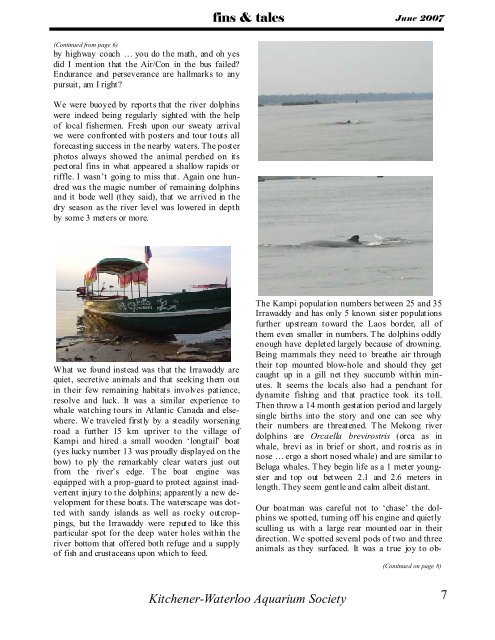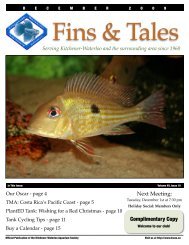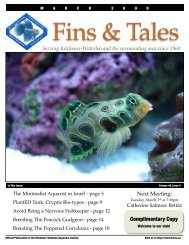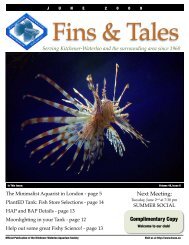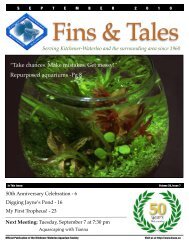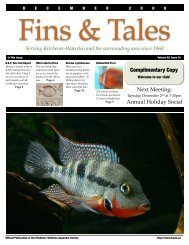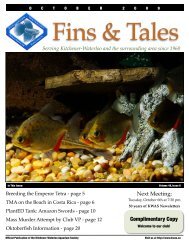June 2007 - Kitchener Waterloo Aquarium Society
June 2007 - Kitchener Waterloo Aquarium Society
June 2007 - Kitchener Waterloo Aquarium Society
Create successful ePaper yourself
Turn your PDF publications into a flip-book with our unique Google optimized e-Paper software.
fins & tales <strong>June</strong> <strong>2007</strong><br />
(Continued from page 6)<br />
by highway coach … you do the math, and oh yes<br />
did I mention that the Air/Con in the bus failed?<br />
Endurance and perseverance are hallmarks to any<br />
pursuit, am I right?<br />
We were buoyed by reports that the river dolphins<br />
were indeed being regularly sighted with the help<br />
of local fishermen. Fresh upon our sweaty arrival<br />
we were confronted with posters and tour touts all<br />
forecasting success in the nearby waters. The poster<br />
photos always showed the animal perched on its<br />
pectoral fins in what appeared a shallow rapids or<br />
riffle. I wasn’t going to miss that. Again one hundred<br />
was the magic number of remaining dolphins<br />
and it bode well (they said), that we arrived in the<br />
dry season as the river level was lowered in depth<br />
by some 3 meters or more.<br />
What we found instead was that the Irrawaddy are<br />
quiet, secretive animals and that seeking them out<br />
in their few remaining habitats involves patience,<br />
resolve and luck. It was a similar experience to<br />
whale watching tours in Atlantic Canada and elsewhere.<br />
We traveled firstly by a steadily worsening<br />
road a further 15 km upriver to the village of<br />
Kampi and hired a small wooden ‘longtail’ boat<br />
(yes lucky number 13 was proudly displayed on the<br />
bow) to ply the remarkably clear waters just out<br />
from the river’s edge. The boat engine was<br />
equipped with a prop-guard to protect against inadvertent<br />
injury to the dolphins; apparently a new development<br />
for these boats. The waterscape was dotted<br />
with sandy islands as well as rocky outcroppings,<br />
but the Irrawaddy were reputed to like this<br />
particular spot for the deep water holes within the<br />
river bottom that offered both refuge and a supply<br />
of fish and crustaceans upon which to feed.<br />
The Kampi population numbers between 25 and 35<br />
Irrawaddy and has only 5 known sister populations<br />
further upstream toward the Laos border, all of<br />
them even smaller in numbers. The dolphins oddly<br />
enough have depleted largely because of drowning.<br />
Being mammals they need to breathe air through<br />
their top mounted blow-hole and should they get<br />
caught up in a gill net they succumb within minutes.<br />
It seems the locals also had a penchant for<br />
dynamite fishing and that practice took its toll.<br />
Then throw a 14 month gestation period and largely<br />
single births into the story and one can see why<br />
their numbers are threatened. The Mekong river<br />
dolphins are Orcaella brevirostris (orca as in<br />
whale, brevi as in brief or short, and rostris as in<br />
nose … ergo a short nosed whale) and are similar to<br />
Beluga whales. They begin life as a 1 meter youngster<br />
and top out between 2.1 and 2.6 meters in<br />
length. They seem gentle and calm albeit distant.<br />
Our boatman was careful not to ‘chase’ the dolphins<br />
we spotted, turning off his engine and quietly<br />
sculling us with a large rear mounted oar in their<br />
direction. We spotted several pods of two and three<br />
animals as they surfaced. It was a true joy to ob-<br />
(Continued on page 8)<br />
<strong>Kitchener</strong>-<strong>Waterloo</strong> <strong>Aquarium</strong> <strong>Society</strong><br />
7


